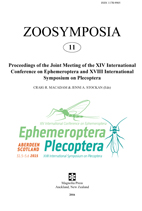Abstract
Prosopistomatidae are a monotypic mayfly family, comprising at present about 25 nominal species, distributed throughout the Palaearctic, Oriental, Australian and Afrotropical Realms, but missing from the Nearctic and Neotropics. Larvae of Prosopistoma pennigerum (the species name ’pennigerum’ relating to the feather-like caudal filaments) had been discovered in 1762 by Étienne Louis Geoffroy in the neighbourhood of Paris and initially considered to represent a taxon related to Triops SCHRANK (Crustacea: Notostraca). Only in 1871, more than 100 years later, Émile Joly realized that the ‘binocle à queue en plumet’ was in fact a mayfly larva. Although recorded from various rivers throughout Europe in the past, nowadays most populations are considered lost or extinct. In 2006 the species was found in the Volga River, which represented the first record from the Russian Federation. On the basis of this material a detailed larval redescription of P. pennigerum is provided and discriminating characters and their variation are compared with previous descriptions and illustrations. The morphological description includes micrographs of relevant features, produced with special image processing software. Presumptive larval habitat requirements of P. pennigerum as observed at the R. Volga are summarized and discussed in comparison with earlier records.

